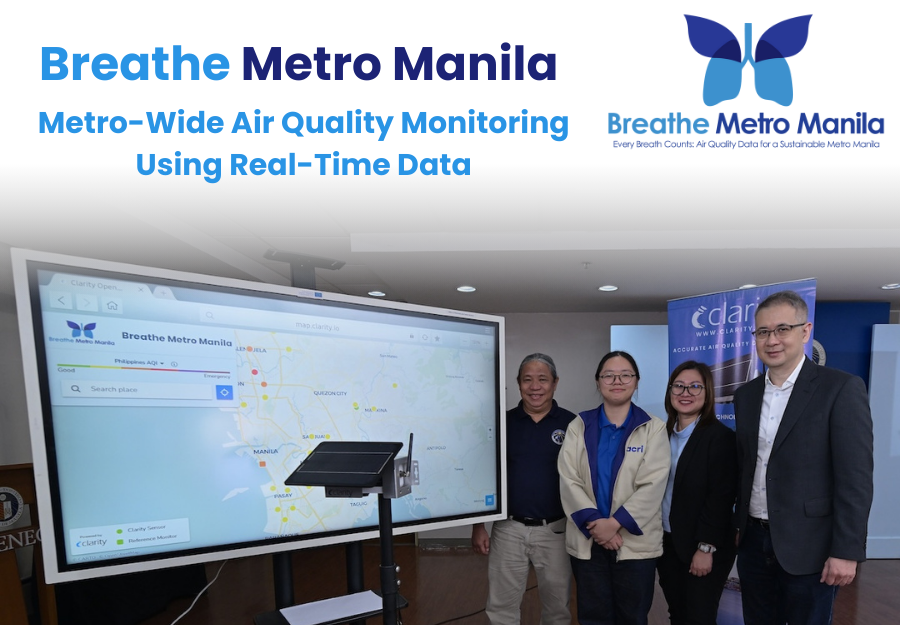A new coalition advocates for real-time air quality data and collaborative solutions amidst Metro Manila’s air pollution crisis
MANILA, Philippines — Health experts warn that air pollution in Metro Manila has worsened from an environmental problem to a serious public health concern. Over 13 million residents are regularly exposed to pollution levels that surpass global safety standards. These invisible dangers are contributing to respiratory, cardiovascular, and neurological diseases that take lives and burden communities.
The State of Global Air 2024 report cited by the Ateneo School of Medicine and Public Health (ASMPH) identified poor air quality as the leading environmental threat to human health, accounting for 8.1 million deaths worldwide in 2021. Fine particulate matter, such as PM2.5, can bypass the body’s natural defenses and enter the bloodstream and brain. These particles are linked to a range of illnesses, including asthma, heart disease, stroke, and cancer.
Breathe Metro Manila, an emerging coalition of technology and academic institutions specializing in air quality science, public health, and research innovation, is working directly to confront this crisis. The group is advocating for stronger air quality monitoring and data-driven solutions to reduce health risks linked with pollution.
Air pollution is the leading cause of disease and early death worldwide, even more than high blood pressure or smoking, and yet, we don’t have enough publicly available data to protect the populations most at risk."
— Dr. Annelle Raphayette T. Chua, Head of the Innovation Flagship Program at ASMPH Center for Research and Innovation (ACRI) and Focal for Environmental Quality and Health at ASMPH.
Making the Invisible Visible: Real-time Data for Real-World Decisions
That visibility is what Breathe Metro Manila aims to provide. The coalition’s goal is to expand real-time air quality monitoring, making pollution data accessible to decision-makers, healthcare providers, and the general public. This aligns directly with the objectives of the National Environmental Health Action Plan (NEHAP) 2030, which calls for strengthened systems that protect Filipinos’ health from environmental risks.
This emphasis on evidence-based action reflects decades of research from institutions like the Manila Observatory, which highlights the importance of ongoing, localized measurement.
You cannot manage what you cannot measure. Long-term measurements illustrate the effectiveness of AQ-relevant policy decisions. Understanding the major sources of air pollution helps direct air pollution mitigation and control strategies."
— Dr. James Bernard Simpas, Head of the Air Quality Dynamics Laboratory at the Manila Observatory
Local governments already use this kind of timely, localized data. In Quezon City, Mayor Joy Belmonte recently updated the city’s class suspension protocols to consider real-time air quality as a factor. When levels reach “Very Unhealthy” or “Emergency,” classes are automatically canceled based on sensor data from 40 active monitoring sites.
Behind these actions are Breathe Metro Manila’s partners, who provide the infrastructure, coordination, and tools needed to increase impact. Among them is Ateneo BUILD (Business Insights Laboratory for Development), which acts as the initiative’s operational and fiduciary hub. BUILD helps translate shared goals into action by connecting academic work with government, civic, and industry partners.
Across Ateneo are groups with deep, world-class expertise: in environmental science, public health, innovation, and more. But to be appreciated and engaged by partners outside the university, these strengths often need a bridge. That’s where BUILD comes in. Making air quality data public is a milestone. But more important is turning that visibility into shared decisions, and decisions into systems that improve how we protect our communities.”
— Joseph Benjamin R. Ilagan, Director of Ateneo BUILD
Clarity, a leader in environmental sensing, is developing Node-S Air Sensor, its flagship self-powered particulate matter and nitrogen dioxide monitor, to be deployed across Metro Manila. Their platform supports what they call Air Quality Monitoring 2.0, which focuses on three main shifts: (1) deploying smarter, scalable measurement systems; (2) turning data into actionable health and economic insights; and (3) coordinating efforts across sectors to create lasting change.
Air quality data is only powerful when it’s real-time, localized, and actionable. With smarter sensors and stronger partnerships, we’re helping Metro Manila turn invisible threats into visible solutions.”
— Engr. Ethel Garcia, Regional Account Manager for SEA and Oceania, Clarity Movement
Breathe Metro Manila is calling on local governments, private sector leaders, schools, and civic organizations to support ongoing efforts to improve air quality and safeguard public health. With real-time data, coordinated action, and cross-sector collaboration, the coalition aims to transform air quality insights into policies and interventions that yield long-term impact.
- You can learn more about the Breathe Metro Manila initiative here: https://breathemetromanila.org
- View Breathe Metro Manila's real-time air quality map here: https://breathemetromanila.org/map-and-monitoring/
- Learn about how to support Breathe Metro Manila' with a sponsorship here: https://breathemetromanila.org/get-involved/
###
